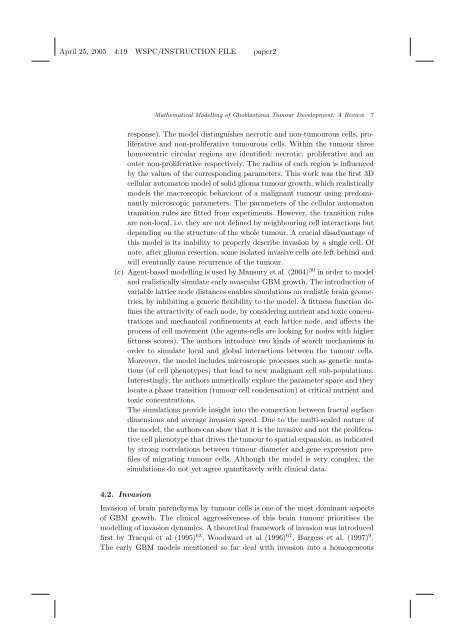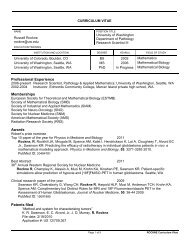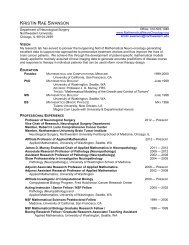April 25, 2005 4:19 WSPC/INSTRUCTION FILE paper2 ...
April 25, 2005 4:19 WSPC/INSTRUCTION FILE paper2 ...
April 25, 2005 4:19 WSPC/INSTRUCTION FILE paper2 ...
You also want an ePaper? Increase the reach of your titles
YUMPU automatically turns print PDFs into web optimized ePapers that Google loves.
<strong>April</strong> <strong>25</strong>, <strong>2005</strong> 4:<strong>19</strong> <strong>WSPC</strong>/<strong>INSTRUCTION</strong> <strong>FILE</strong> <strong>paper2</strong><br />
Mathematical Modelling of Glioblastoma Tumour Development: A Review 7<br />
response). The model distinguishes necrotic and non-tumourous cells, proliferative<br />
and non-proliferative tumourous cells. Within the tumour three<br />
homocentric circular regions are identified: necrotic, proliferative and an<br />
outer non-proliferative respectively. The radius of each region is influenced<br />
by the values of the corresponding parameters. This work was the first 3D<br />
cellular automaton model of solid glioma tumour growth, which realistically<br />
models the macroscopic behaviour of a malignant tumour using predominantly<br />
microscopic parameters. The parameters of the cellular automaton<br />
transition rules are fitted from experiments. However, the transition rules<br />
are non-local, i.e. they are not defined by neighbouring cell interactions but<br />
depending on the structure of the whole tumour. A crucial disadvantage of<br />
this model is its inability to properly describe invasion by a single cell. Of<br />
note, after glioma resection, some isolated invasive cells are left behind and<br />
will eventually cause recurrence of the tumour.<br />
(c) Agent-based modelling is used by Mansury et al. (2004) 30 in order to model<br />
and realistically simulate early avascular GBM growth. The introduction of<br />
variable lattice node distances enables simulations on realistic brain geometries,<br />
by inhibiting a generic flexibility to the model. A fittness function defines<br />
the attractivity of each node, by considering nutrient and toxic concentrations<br />
and mechanical confinements at each lattice node, and affects the<br />
process of cell movement (the agents-cells are looking for nodes with higher<br />
fittness scores). The authors introduce two kinds of search mechanisms in<br />
order to simulate local and global interactions between the tumour cells.<br />
Moreover, the model includes microscopic processes such as genetic mutations<br />
(of cell phenotypes) that lead to new malignant cell sub-populations.<br />
Interestingly, the authors numerically explore the parameter space and they<br />
locate a phase transition (tumour cell condensation) at critical nutrient and<br />
toxic concentrations.<br />
The simulations provide insight into the connection between fractal surface<br />
dimensions and average invasion speed. Due to the multi-scaled nature of<br />
the model, the authors can show that it is the invasive and not the proliferative<br />
cell phenotype that drives the tumour to spatial expansion, as indicated<br />
by strong correlations between tumour diameter and gene expression profiles<br />
of migrating tumour cells. Although the model is very complex, the<br />
simulations do not yet agree quantitavely with clinical data.<br />
4.2. Invasion<br />
Invasion of brain parenchyma by tumour cells is one of the most dominant aspects<br />
of GBM growth. The clinical aggressiveness of this brain tumour prioritises the<br />
modelling of invasion dynamics. A theoretical framework of invasion was introduced<br />
first by Tracqui et al (<strong>19</strong>95) 63 , Woodward et al (<strong>19</strong>96) 67 , Burgess et al. (<strong>19</strong>97) 9 .<br />
The early GBM models mentioned so far deal with invasion into a homogeneous





